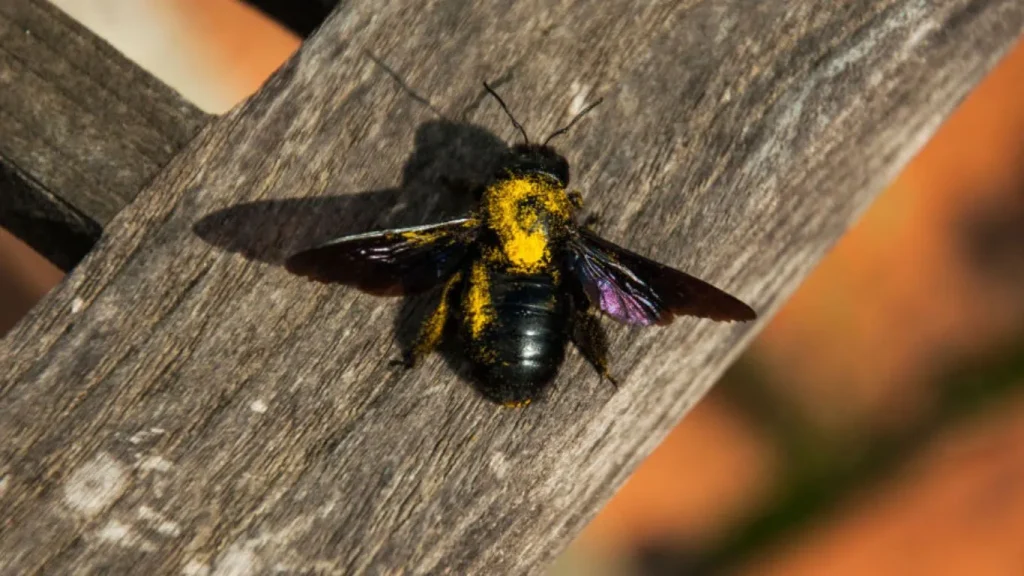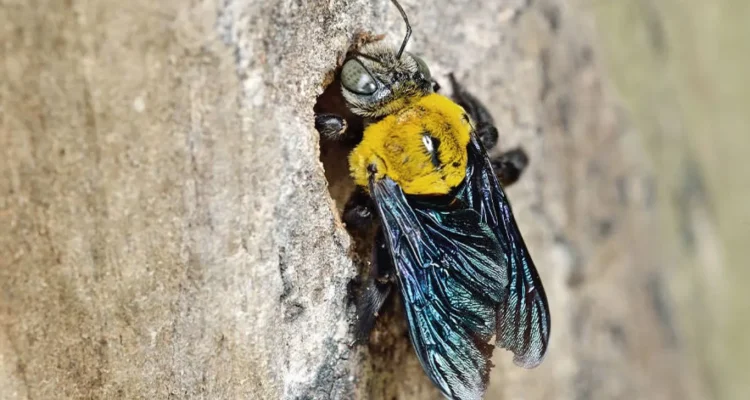Introduction
Wood bees, also known as carpenter bees, can be a real nuisance. These buzzing invaders bore holes into wood, potentially causing significant structural damage over time. But don’t worry, there are plenty of ways to keep them at bay. In this guide, we’ll explore various strategies to protect your home and keep wood bees away for good.

Understanding Wood Bees
What Are Wood Bees?
Wood bees, commonly referred to as carpenter bees, are large, solitary bees known for their wood-boring habits. Unlike honeybees, they don’t live in colonies. Instead, female carpenter bees create individual nests by tunneling into wood.
Characteristics and Behavior
Carpenter bees are often mistaken for bumblebees due to their similar appearance. However, they can be distinguished by their shiny, hairless abdomens. These bees are most active during the spring and summer months. The males, while aggressive, don’t have stingers, and the females rarely sting unless provoked.
Why Wood Bees Are a Problem
Damage Caused by Wood Bees
The primary issue with wood bees is the damage they cause to wooden structures. They drill into wood to lay their eggs, creating a network of tunnels that can weaken and deteriorate the wood over time. This can lead to costly repairs if left unchecked.
Health Concerns
While wood bees are not particularly dangerous, their presence can cause anxiety, especially for those who are allergic to bee stings. Additionally, their activity can attract other pests like woodpeckers, which seek out the larvae inside the tunnels.
Identifying Wood Bees
Physical Appearance
Identifying carpenter bees is relatively straightforward. They have a robust, shiny black body, with males often displaying a yellow face. Their wings are transparent and slightly tinged with a dark color.
Signs of Infestation
Common signs of a carpenter bee infestation include:
- Small, perfectly round holes in wood surfaces
- Sawdust-like debris beneath these holes
- The presence of bees hovering around wooden structures
Preventative Measures
Sealing Wood Surfaces
One of the best ways to prevent carpenter bee infestations is by sealing all wood surfaces. Use a high-quality wood sealant to cover exposed wood, paying special attention to cracks and crevices where bees might enter.
Painting and Staining
Carpenter bees prefer untreated wood. Painting or staining your wooden structures not only improves their appearance but also acts as a deterrent. Bees are less likely to drill into painted or stained wood.
Using Hardwood
If possible, use hardwood for your structures. Carpenter bees are more attracted to softwoods like pine and cedar. Hardwood, being denser, is less appealing for these bees to drill into.
Natural Repellents
Citrus Oil
Citrus oil is a natural deterrent for carpenter bees. The strong scent of citrus is unappealing to them. You can make a citrus spray by boiling citrus peels in water and then spraying the mixture onto wood surfaces.
Almond Oil
Almond oil is another effective natural repellent. Applying it to wood surfaces can help keep carpenter bees away. Reapply periodically, especially after rain.
Essential Oils
Essential oils such as lavender, tea tree, and eucalyptus are known to repel wood bees. Mix a few drops of these oils with water and spray onto wooden surfaces regularly.
Chemical Solutions
Insecticidal Dust
Insecticidal dust is a powerful solution for treating carpenter bee infestations. Apply the dust directly into the bee holes using a duster. The bees will carry the dust into their nests, effectively eliminating them.
Sprays and Foams
There are various commercial sprays and foams designed to kill carpenter bees. These products can be sprayed into the holes and around the infested areas. Be sure to follow the instructions carefully for best results.
Creating an Unfriendly Environment
Noise Deterrents
Carpenter bees dislike loud noises. Installing wind chimes or playing loud music near their nesting sites can encourage them to leave.
Reflective Surfaces
Reflective surfaces, like aluminum foil or shiny tape, can deter carpenter bees. The reflections confuse and disorient the bees, making the area less attractive for nesting.
Wood Bee Traps
DIY Traps
You can make your own carpenter bee traps using a simple wooden box with a plastic bottle attached. The bees enter the box through pre-drilled holes and get trapped in the bottle.
Commercial Traps
There are also commercial traps available that are specifically designed to catch carpenter bees. These traps are often more effective and easier to use than DIY options.
Professional Help
When to Call a Professional
If you have a severe infestation or the bees have caused significant damage, it might be time to call a professional pest control service. They have the expertise and tools to effectively deal with the problem.
What to Expect from Professional Services
A professional service will inspect your property, identify the extent of the infestation, and implement a treatment plan. They may use a combination of chemical treatments, traps, and preventative measures to ensure the bees are eliminated and do not return.
Maintenance Tips
Regular Inspections
Regularly inspect your property for signs of carpenter bees, especially during the spring and summer months. Early detection can prevent a minor problem from becoming a major issue.
Seasonal Precautions
Take extra precautions during the spring when carpenter bees are most active. Seal any new holes and apply repellents as needed to keep them from establishing new nests.
Wood Bee Myths
Common Misconceptions
There are several myths about carpenter bees that can lead to ineffective control measures. For example, some people believe that killing a carpenter bee will attract more. This is not true; taking action against these bees is necessary to protect your property.
Truths About Wood Bees
Understanding the true behavior and characteristics of carpenter bees can help you effectively manage them. They are solitary, do not eat wood, and are important pollinators despite their destructive nesting habits.
FAQs
1. How can I tell if I have a carpenter bee infestation?
Look for small, round holes in wood surfaces, sawdust-like debris, and bees hovering around wooden structures.
2. Are carpenter bees dangerous?
While carpenter bees can sting, they are not typically aggressive. The primary concern is the damage they cause to wood.
3. What is the best natural repellent for carpenter bees?
Citrus oil and almond oil are effective natural repellents. Essential oils like lavender and tea tree oil also work well.
4. Can I use a regular insect spray to kill carpenter bees?
Regular insect sprays may not be effective. Use insecticidal dust or sprays specifically designed for carpenter bees.
5. When should I call a professional for a carpenter bee problem?
Call a professional if you have a severe infestation or significant damage to your wood structures. They can provide effective treatment and prevention plans.
Conclusion
Carpenter bees can be a real headache, but with the right knowledge and tools, you can keep them away from your home. Whether you choose natural repellents, chemical solutions, or professional help, taking proactive steps will protect your wood structures from damage.


Congratulation!